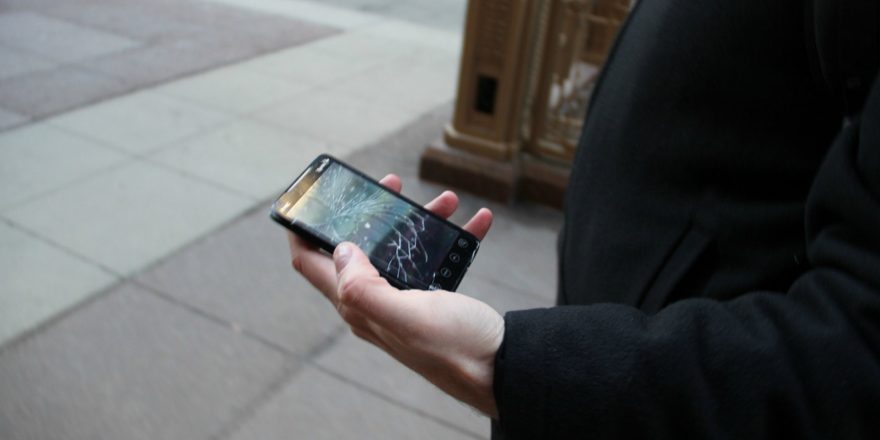A smartphone can make tour a completely different experience if you’re a musician who’s always on the road. It can entertain you during long stretches in the van — and it’s always nice to be able to navigate a city you’ve never been to before, and, in my case, look up the best coffee shops. It’s also important when it comes to staying in contact with your band mates or manager in a foreign city. I’ve been lost in many unfamiliar places, and I can honestly say there are few things more stressful. So, when I dropped my iPhone 6 and shattered the screen, you could say I was less than pleased. It’s not usually in the budget — especially for most touring musicians — to just up and buy a new piece of gear.
I was recently talking to my friend Brandon, who is the most technically capable person I’ve ever met and one of my oldest friends. We talked about the effect the Internet has had upon the human brain — more specifically, memory — and how the ability to instantly retrieve information on nearly any topic could nullify the need to memorize certain things. We laughed at the thought of using a map, writing down directions and frequently pulling out a piece of paper while riding your bike on busy streets. We talked about mail and how seemingly arduous it was to sit down and write a letter to our grandmas when we were kids, but how easy it is to email them today. Finally, we arrived at the topic of repair: the collective storage on the Web of owner’s manuals, user guides, lists of specifications and step-by-step repair instructions struck both of us as nothing short of astounding. Thinking of the wealth of model-specific information all stored and ready for retrieval at the push of a few buttons quite literally made me emotional.
“There’s nothing we can’t fix!” I exclaimed.
“Nothing,” he agreed.
In the world of amp repair, every little bit helps and could save you a lot of money. So why should iPhone repair be any different?
I decided then and there to fix my shattered iPhone myself. The thought of paying someone a substantial amount of money (any amount of money is substantial to a touring musician) to someone who was just following instructions seemed absurd to me. While sometimes it might be a little beyond my experience to fix an amp or pedal, I’ve definitely become accustomed to, at the bare minimum, troubleshooting and isolating the problem when something inexplicably stops working. In the world of amp repair, every little bit helps and could save you a lot of money. So why should iPhone repair be any different?
I navigated the endless iPhone 6 specific videos, forums, blogs and publications and ordered an Apple tool kit. I was excited to take matters into my own hands, and I felt I was genuinely prepared for whatever Apple could throw at me. However, upon opening my phone, I realized that this would be harder than I had imagined. The precision required was on a surgical level, and as I reached the step in which I was to detach the screen assembly from the paper-thin aluminum frame, I remembered that this was the part that every video and walk-through had said was exceedingly difficult.
As I went to remove the minute screws from the side of the most delicate and thin piece of aluminum I’ve ever seen, I realized in horror that there was some sort of adhesive in place making the removal of the screws almost impossible without damaging the frame. Refusing to be conquered by an “evil corporation,” I took the plunge, and completely ruined the frame, rendering my phone, at that point in time, irreparable. I instantly felt the twinge of failure, but before it had enough time to resonate, I felt more betrayed and annoyed than anything else. It felt as if some unforeseen force was determined to make the process more difficult.
I wanted to finish the job, though, so I started looking for a new frame online. Oddly, all the frames I found were generic — available only through weird companies I had never heard of before. I could not find any straightforward way to order from Apple. And that’s when I first heard about the Fair Repair Act — via frequent pop-ups notices that read, “Fight for your right to repair!” This was a reaction to a kind of corporate greed I didn’t know existed — a brand not as cut and dried as a chokehold on money or land. It was an embargo on knowledge.
I was beginning to understand that my failure was not only a product of inexperience, but was also being facilitated by Apple itself.
Basically, through research, I found that big electronic manufacturers withhold a lot of information concerning the repair of their products with the intention of being the only entities that are able to fix them. To me, someone who is genuinely curious about the inner workings of a lot of these things, it was very disheartening to understand that I legally may not acquire the parts I need to fix my phone — unless I am an authorized Apple service provider. I was beginning to understand that my failure was not only a product of inexperience, but was also being facilitated by Apple itself.
The solution to this problem, the Fair Repair Act, would “require the manufacturers of digital electronic parts to offer for sale diagnostic and repair information in the same manner as such manufacturer provides such diagnostic and repair information to such manufacturers repair channel.” That bill, however, is now sitting in the Senate committee, where it will be voted on again by the Senate in spring of 2017.
Not naïve enough to feel betrayed, I was simply annoyed. I use a lot of the well-packaged and user-friendly applications that this company has to offer. Don’t I already pay enough? For years I turned a blind eye to planned obsolescence, but this was too much. I was upset that I had apprehensively agreed to purchase a new product every few years, but the thought of that process being accelerated if I make a mistake and drop my phone seemed so outrageous to me. Between loading and unloading, dropping and throwing, tour is the most perfect storm when it comes to breaking things. I’ve had phones just stop charging, and more broken screens than I can count. On top of paying $12 per month for insurance, I still have to pay $200 to get my phone fixed? And my only form of resistance through self repair was also under Apple’s chokehold?! It quite simply seemed wrong.
To acquire certified parts from a company such as Apple, I first would have to apply to become an Authorized Apple Service Provider. Upon acceptance, I would be trained by Apple technicians — for a cost. To become an actual certified Apple technician, you must take courses and pass an annual exam, which costs $150 per year. While I understand the capitalist lens these companies are looking through, it is very concerning to me that for the few people willing to put in the effort and research, the option to repair your own electronics legally does not exist. Even if it were a fix-at-your-own-risk situation, should it not at least be legal? And is it so monetarily damaging to put your willing customers in a better position to be self-sufficient? After all, we are not asking for free parts or diagnostics, just the right to buy them.
While I understand the methodology of capitalist umbrellas reaching to such outer rims as self-repair, is honoring loyalty so out of the question?
In the end, while I understand the methodology of capitalist umbrellas reaching to such outer rims as self-repair, is honoring loyalty so out of the question? In an age where so many people are willing to just purchase a new product at the instant of displeasure or happily plan their lives around the next upgrade, I firmly believe the monetary impact of the Fair Repair Act on big corporations would be almost immeasurable. It takes a lot of time and research to learn how to fix your own electronics, and I think most people would happily just buy a new one.
In my research I did, however, find a scattered presence doing everything possible to not only enable people to make their own repairs, but promote self-sufficiency all around. I was so excited to find out about the movement of Repair Cafes, pop-up shops where someone can bring in virtually anything and a team of individuals will sit down and research how to fix it. Then, if all the right tools are in house, they, with the assistance of the product’s owner, will fix it on the spot.
This struck me as such a wonderful process because it is not the same as dropping your device off at the repair shop; it’s a transfer of knowledge. Not only the knowledge of how to fix any particular thing, but the knowledge of the process. These groups teach you how to research, find the right parts and tools, and other skills that apply to fixing many different electronics. With a wealth of them turning up all across the country, I am excited to see a movement with so many positive side effects. Besides the general awareness of the ability to repair one’s own goods, which we seemingly tend to forget, it also helps alleviate the growing problem of waste. Instead of buying new, why not recycle every part of an electronic device you can? I have since set aside an old drum machine that I can’t wait to take to the first pop-up I hear about.
Besides these physical locations, I was also amazed to find entire online communities such as ifixit.com, which not only acts as an instructional website providing thousands of manuals and instructional publications, but also has tools and parts for countless different kinds of electronic devices. There is a collection of comfortable forums where you can ask anything and even create a login and leave your own “fix it” experiences. Besides strictly electronics, there is doityourself.com with endless instructional videos of home repair and even vehicle repair. Music equipment can be a little more specific, but I found that a little research with specific problems yields a lot of great results.
This experience has taught me there is no excuse.
Perhaps the most comforting thing to come from this whole experience, besides the raw knowledge, was the realization that I am not alone. The feelings of inadequacy and inexperience were almost instantly met with a whole support system that seemed to scream, “Don’t worry, we are all fighting against the wasteful repetition of buying anew, and our main weapon is knowledge.”
In the age of the Internet, it’s as if there is a collective learning experience. I can log in and learn by someone else’s trial and error. It’s the ultimate community of shared experiences, and who am I to not use that? Who am I to constantly praise the spread of information without tapping into it myself?
This experience has taught me there is no excuse. I have the tools, I have the will, and I am choosing to exercise them. I remember in my conversation with Brandon the admiration we both felt for the real-life applications the Internet has given us, but I now realize admiration and utilization are two different things. What a waste it would be to not use this digital library to its full extent, because the ability to instantly access a virtually endless world of knowledge is what truly separates our generation from the last. And there is no better way to fight corporations’ greed than to unreservedly use the very thing you are paying them for.
(Photo credit: Daniel X. O’Neil)








